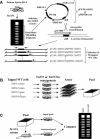Large-scale identification of genes required for full virulence of Staphylococcus aureus
- PMID: 15576798
- PMCID: PMC532413
- DOI: 10.1128/JB.186.24.8478-8489.2004
Large-scale identification of genes required for full virulence of Staphylococcus aureus
Abstract
Gene products required for in vivo growth and survival of microbial pathogens comprise a unique functional class and may represent new targets for antimicrobial chemotherapy, vaccine construction, or diagnostics. Although some factors governing Staphylococcus aureus pathogenicity have been identified and studied, a comprehensive genomic analysis of virulence functions will be a prerequisite for developing a global understanding of interactions between this pathogen and its human host. In this study, we describe a genetic screening strategy and demonstrate its use in screening a collection of 6,300 S. aureus insertion mutants for virulence attenuation in a murine model of systemic infection. Ninety-five attenuated mutants were identified, reassembled into new pools, and rescreened using the same murine model. This effort identified 24 highly attenuated mutants, each of which was further characterized for virulence attenuation in vivo and for growth phenotypes in vitro. Mutants were recovered in numbers up to 1,200-fold less than wild type in the spleens of systemically infected animals and up to 4,000-fold less than wild type in localized abscess infections. Genetic analysis of the mutants identified insertions in 23 unique genes. The largest gene classes represented by these mutants encoded enzymes involved in small-molecule biosynthesis and cell surface transmembrane proteins involved in small-molecule binding and transport. Additionally, three insertions defined two histidine kinase sensor-response regulator gene pairs important for S. aureus in vivo survival. Our findings extend the understanding of pathogenic mechanisms employed by S. aureus to ensure its successful growth and survival in vivo. Many of the gene products we have identified represent attractive new targets for antibacterial chemotherapy.
Figures



Similar articles
-
Identification of Staphylococcus aureus virulence genes in a murine model of bacteraemia using signature-tagged mutagenesis.Mol Microbiol. 1997 Oct;26(2):399-407. doi: 10.1046/j.1365-2958.1997.5911966.x. Mol Microbiol. 1997. PMID: 9383163
-
Staphylococcus aureus genetic loci impacting growth and survival in multiple infection environments.Mol Microbiol. 1998 Oct;30(2):393-404. doi: 10.1046/j.1365-2958.1998.01075.x. Mol Microbiol. 1998. PMID: 9791183
-
Poly-N-acetylglucosamine production in Staphylococcus aureus is essential for virulence in murine models of systemic infection.Infect Immun. 2005 Oct;73(10):6868-76. doi: 10.1128/IAI.73.10.6868-6876.2005. Infect Immun. 2005. PMID: 16177366 Free PMC article.
-
Virulence regulation in Staphylococcus aureus: the need for in vivo analysis of virulence factor regulation.FEMS Immunol Med Microbiol. 2004 Oct 1;42(2):147-54. doi: 10.1016/j.femsim.2004.05.005. FEMS Immunol Med Microbiol. 2004. PMID: 15364098 Review.
-
From the genome sequence via the proteome to cell physiology - Pathoproteomics and pathophysiology of Staphylococcus aureus.Int J Med Microbiol. 2018 Aug;308(6):545-557. doi: 10.1016/j.ijmm.2018.01.002. Epub 2018 Jan 5. Int J Med Microbiol. 2018. PMID: 29398252 Review.
Cited by
-
An update on the molecular genetics toolbox for staphylococci.Microbiology (Reading). 2013 Mar;159(Pt 3):421-435. doi: 10.1099/mic.0.061705-0. Epub 2013 Feb 1. Microbiology (Reading). 2013. PMID: 23378573 Free PMC article. Review.
-
New insights into the WalK/WalR (YycG/YycF) essential signal transduction pathway reveal a major role in controlling cell wall metabolism and biofilm formation in Staphylococcus aureus.J Bacteriol. 2007 Nov;189(22):8257-69. doi: 10.1128/JB.00645-07. Epub 2007 Sep 7. J Bacteriol. 2007. PMID: 17827301 Free PMC article.
-
Bioinformatics annotation of the hypothetical proteins found by omics techniques can help to disclose additional virulence factors.Curr Microbiol. 2009 Oct;59(4):451-6. doi: 10.1007/s00284-009-9459-y. Epub 2009 Jul 28. Curr Microbiol. 2009. PMID: 19636617 Review.
-
Staphylococcus aureus uses the ArlRS and MgrA cascade to regulate immune evasion during skin infection.Cell Rep. 2021 Jul 27;36(4):109462. doi: 10.1016/j.celrep.2021.109462. Cell Rep. 2021. PMID: 34320352 Free PMC article.
-
Signature-tagged mutagenesis of Vibrio vulnificus.J Vet Med Sci. 2015 Jul;77(7):823-8. doi: 10.1292/jvms.14-0655. Epub 2015 Mar 9. J Vet Med Sci. 2015. PMID: 25755021 Free PMC article.
References
-
- Altschul, S., W. Gish, W. Miller, E. Myers, and D. Lipman. 1990. Basic local alignment search tool. J. Mol. Biol. 215:403-410. - PubMed
-
- Anonymous. 1999. National nosocomial infections surveillance (NNIS) system report, data summary from January 1990-May 1999, issued June 1999. Am. J. Infect. Control 27:520-532. - PubMed
-
- Bohach, G. A., D. J. Fast, R. D. Nelson, and P. M. Schlievert. 1990. Staphylococcal and streptococcal pyrogenic toxins involved in toxic shock syndrome and related illnesses. Crit. Rev. Microbiol. 17:251-272. - PubMed
-
- Buysse, J. M. 2001. The role of genomics in antibacterial target discovery. Curr. Med. Chem. 8:1713-1726. - PubMed
-
- Chang, S., D. M. Sievert, J. C. Hageman, M. L. Boulton, F. C. Tenover, F. P. Downes, S. Shah, J. T. Rudrik, G. R. Pupp, W. J. Brown, D. Cardo, and S. K. Fridkin. 2003. Infection with vancomycin-resistant Staphylococcus aureus containing the vanA resistance gene. N. Engl. J. Med. 348:1342-1347. - PubMed
MeSH terms
Substances
LinkOut - more resources
Full Text Sources
Other Literature Sources
Medical

